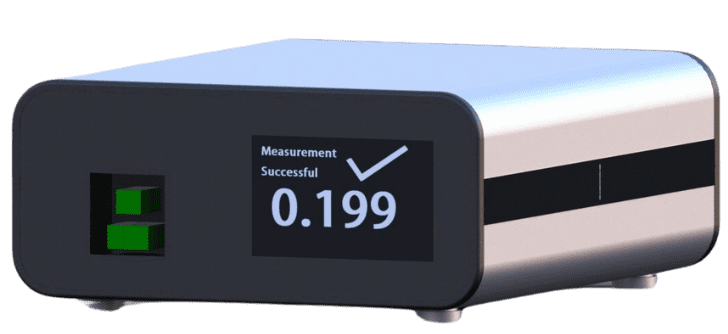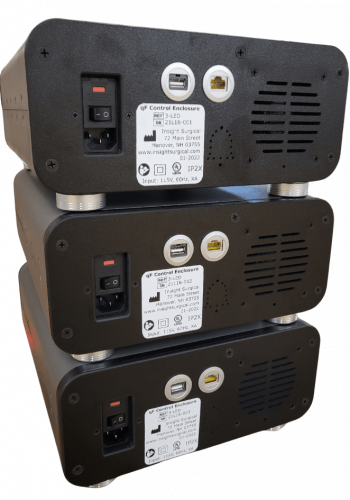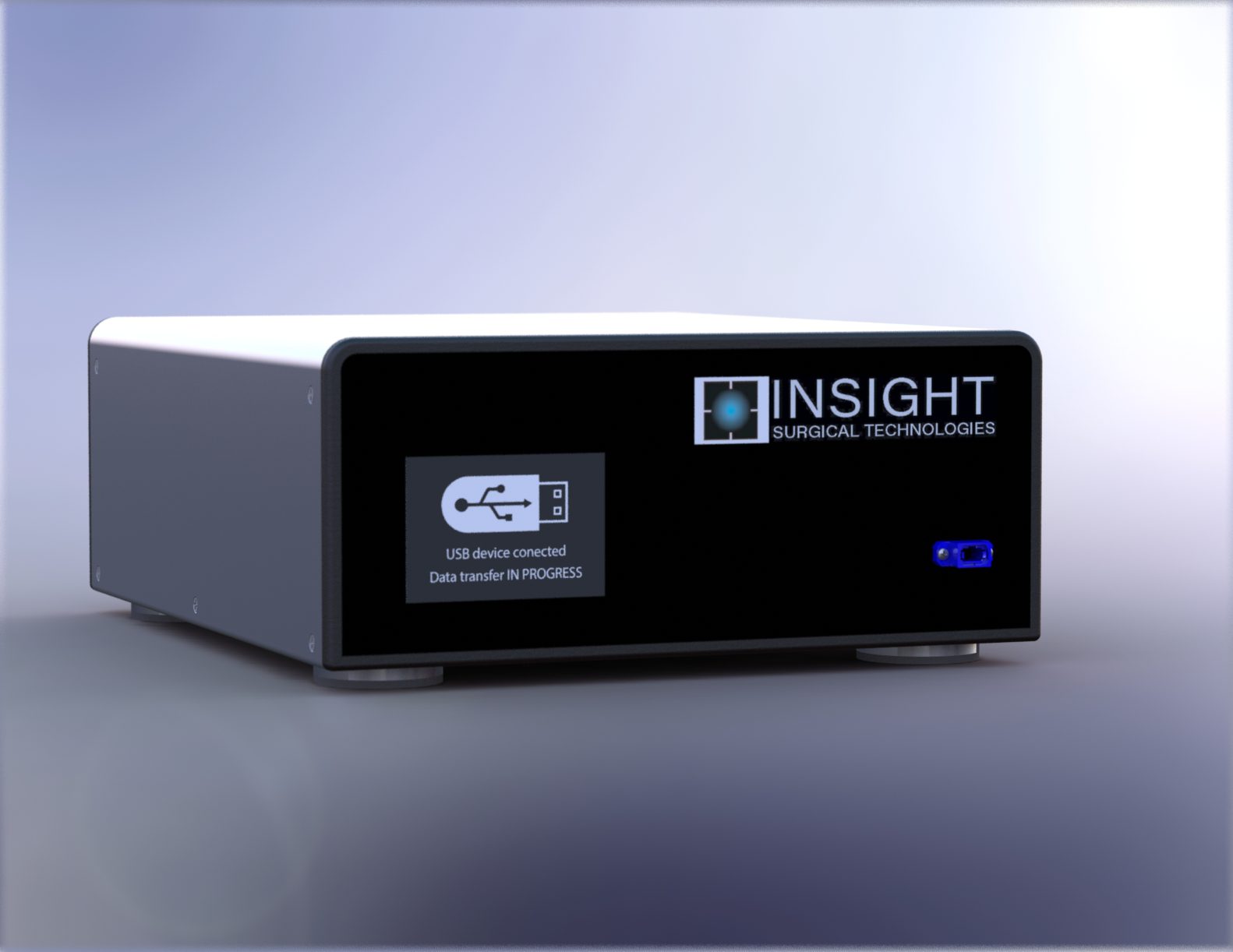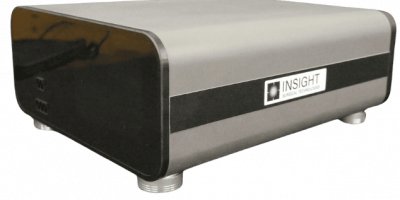
Designing Medical Device Prototypes for Clinical Trials and FDA Approval
Designing an FDA-Approved FGR Device
Insight Surgical Technologies approached Simbex to commercialize and further develop their product for fluorescence-guided resection (FGR) and to create a device which could pass FDA Testing requirements for approval.
While their existing product had been used for research purposes and yielded positive results over the course of several years, Insight Surgical needed a device which could be submitted for approval to the FDA.
Identifying and Meeting Expectations
The first step in any medical device development process is to understand the design inputs. Simbex needed to consider regulatory concerns early into the design process.
Understanding the necessary product features is key to determining the correct regulatory pathway. Once the regulatory strategy is established, the specifications aligning with FDA-mandated standards of design controls and manufacturing practices can be included in the requirements documentation.
While delivery expectations and direction of the product may change throughout the process, all of the product requirements need to be well-defined, documented and verifiable from the start.
Why is this so important?
Product requirements greatly influence the ultimate cost to bring the product to market; the higher the risk, the more clinical data needed. The more clinical data needed, the more expensive the process can get. Getting it right the first time is key

At a Glance
Challenge:
Develop a prototype that will pass testing, on budget, without final tooling.
Simbex Approach:
Draw on commercialization findings to directly answer common industry questions and provide a guide through product development efforts.
Simbex Started with a Commercialization Assessment
Simbex first began with defining the design inputs: what is the necessary function of the device, and what are the requirements for the device?
In addition to these questions, the team needed to consider the clinician’s workflow when working with this instrument, such as:
- What are the steps happening before and after the device is in use?
- Does the use of the device add any steps to an established protocol and if so, are these steps considered burdensome to the clinical team?
- If the tool does require significant changes or add complications, are there any unforeseen consequences that may impact the procedure success rate or the time in surgery, therefore hitting the hospital’s bottom line?
- Do the positive aspects of the device appeal to the decision-makers within the chain of command?
- Does the value of the device translate directly to a willingness to purchase?
- What are the biggest competitors to this device, and why would our customers buy the Insight Surgical device and not another one on the market?
A commercialization assessment provides both clarification to these questions and a guide through the product development efforts.
Drawing on commercialization findings, Simbex moved through software development phases and leveraged both deep materials knowledge and manufacturing expertise. The team developed a control box enclosure with high aesthetic qualities, capability of passing testing requirements while not requiring final tooling, ultimately delivering a built-for-market solution.
Next: A Five Phase Engineering Approach
This process resulted in a 5-phase approach:
-
Phase I
Identify Design Requirements
-
Phase I
Creating an Alpha Prototype
-
Phase III
Use Findings to Create a Beta Prototype
-
Phase IV
Pre-Production
-
Phase V
Preparation for Certification and FDA Clearance
Phase I: Identify Design Requirements
The commercialization process began by crafting a comprehensive evaluation of the market needs, including strategy, pricing, competition, and regulations.
Following this, the team ideally builds a commercialization strategy before the prototyping of the physical device even begins. This allows for the building of a “paper prototype”: a document that explains exactly why this device needs to exist and why it needs to be built in a certain way. This intentional chain of events prevents the development team from finding themselves with an exciting technology that is now in search of a problem to solve.
It is much more efficient to start the commercialization process by building a device based on the customer’s need rather than trying to match a device to an industry need after building it.
Certain aspects of commercialization–such as regulatory and reimbursement–can act as roadblocks at times. There may be statutory limitations that would block a product from reaching the market unless it complies with specific requirements. Understanding this landscape allows the innovation team to reduce risk and expense by designing the right thing the first time.
When designing a product for approval, you have to know what you’re getting yourself into. A detailed commercialization approach often includes:
- A technical assessment of existing design concepts and documentation
- A business opportunity/product strategy assessment
- Target market and prioritization
- Customer use cases (internal & external)
- Critical market requirements
- Critical regulatory and testing requirements
- Rollout process and product life cycle
- Schedule and Budget Constraints
- Customer Discovery Requirements
In order to develop the Product Requirements Document from a place of understanding, Simbex utilized deep regulatory expertise to provide much-needed input on the regulatory pathway and QMS expectations.
Concluding the commercialization assessment guided Simbex toward the technical approach and concept design with appropriate renderings for use in the Phase II (Alpha) submission.
Phase II: Creating an Alpha Prototype
After Simbex assembled the build and assessed how the product might be qualified, the next step was to build the Alpha. A successful Alpha medical device prototype has to address the risks in the product of development and provide a system to test against.
To do so, Simbex drafted a Risk Management Plan (FMEA) and created prototype hardware and software platforms. Next, the team conducted technical feasibility verification of highest risk design components, and worked collaboratively with the client to obtain feedback and iterate in order to refine the design documentation.
These efforts resulted in a stronger Alpha prototype, demonstrating key features and functionality while identifying potential failure areas, allowing the team to document a strategy to overcome design risks and deliver better results from preliminary alternatives testing.
Phase III: Use Findings to Create a Beta Prototype
Once Simbex had created and tested the Alpha prototype, the subsequent step was to create a Beta prototype. The medical device beta prototype needs to look, feel, and act exactly like the product that will ultimately arrive on the market.
To accomplish this, the team dove directly into creating and integrating the hardware and software platform, and then completing component verification testing. After obtaining target-market user feedback, the team then developed both a clinical validation strategy and a product manufacturing plan to deliver a system-level prototype ready for verification and user testing. Concluding this, Simbex then drafted a Manufacturing Requirements Document and Clinical Testing Protocol.

Phase IV: Pre-Production
Following the Alpha and Beta prototype creation, the team moved toward manufacturing design. While some testing circumstances require building 1,000 units for a usability study, Simbex aimed to maintain flexibility and prove usability in a small number of test units.
The challenge: Develop a prototype that will pass testing, on budget, without final tooling.
To meet the challenge head on, the team began revising the design for manufacturing and selecting the appropriate partners. After completing the manufacturing system and fixture design, both regulatory and safety testing and usability and clinical testing began. Finally, the team was able to arrange the pre-production build.
This design work was useful in achieving the pre-production prototypes, verification and validation test reports, and both manufacturing–hardware and the distribution software package.
Phase V: Preparation for Certification and FDA Clearance
After laying the groundwork through meticulous design, prototyping, and pre-production efforts, Simbex entered the pivotal Phase V: gearing the FGR device towards certification and FDA clearance. This stage was critical, marking the transition from prototype to a product ready for clinical use and regulatory scrutiny.
Understanding the gravity of FDA requirements, the team embarked on a multifaceted approach to ensure the device not only met but exceeded the standards set for medical devices. This phase was characterized by several key activities:
- Finalizing Product for Production Environment: Leveraging insights gained from the Alpha and Beta prototypes, Simbex completed the transition of hardware and software into a production-ready state. This included final adjustments to the manufacturing system and fixture design, ensuring the device could be produced at scale while adhering to the stringent quality controls required by the FDA.
- Comprehensive First-Article Testing: To guarantee each component of the device met the necessary specifications and regulatory requirements, first-article testing was rigorously conducted. This critical step served to validate the manufacturing process and the product’s consistency, marking a significant milestone towards certification.
- Refined Test Protocols: Building on the foundation of regulatory and safety testing, usability, and clinical testing initiated in Phase IV, the team further developed and executed detailed test protocols. These protocols were designed to rigorously evaluate the device’s performance, safety, and efficacy, providing the comprehensive data required for FDA submission.
- Engagement and Documentation for FDA Submission: With the pre-production build completed and test protocols executed, Simbex compiled the verification and validation test reports, manufacturing documentation, and the distribution software package. This documentation formed the backbone of the FDA submission, meticulously detailing every aspect of the device’s design, testing, and manufacturing process.
- Strategic Partnerships and Expert Consultation: Recognizing the complexities of FDA clearance, Simbex Commercialization team and regulatory experts leveraged partnerships with manufacturing and clinical entities. These strategic collaborations were vital in navigating the regulatory landscape, optimizing the submission for FDA review, and preparing for potential audits.
By the conclusion of Phase V, Simbex had transformed the vision of Insight Surgical Technologies into a tangible, clinically ready device, poised for FDA review. This phase not only underscored Simbex’s commitment to excellence and regulatory compliance but also set the stage for the next leap towards bringing a revolutionary medical device to the market.

The Result: a Clinical-Trial Ready Product!
Simbex worked with the Insight Surgical Team to take their research unit for the detection of glioma cells during surgical resection and turn it into a marketable and regulated product. This required an understanding of the market and user needs, regulatory evaluation, and the development of an alpha and beta unit. The team concluded this project with the production of units that were ready for clinical trials, certification testing, and all documentation required for FDA clearance.
Working with early stage companies like Insight Surgical and managing a distributed workforce requires a high attention to budget, timelines, and excellent communication to ensure project success. Simbex is proud to have helped drive their product development journey!





